Kimberly Nicholas's Blog, page 2
November 28, 2024
How to free your bandwidth for what matters
Welcome to We Can Fix It, where we tackle the climate crisis with facts, feelings, and action, written by me, climate scientist Kim Nicholas.
Hi friends, this month I’m sharing our new rural report card for European agriculture, feeling resolute in a global leadership vacuum, and questioning my relationship with social media.
Facts: Food vs. people and planet?To achieve a climate-safe and sustainable world, we must measure and incentivize sustainability outcomes, like reducing greenhouse gas emissions and protecting high-nature value farmland.
Measuring outcomes is essential because it tracks progress and holds policymakers accountable. But too often, analyses focus on actions (like applying fertilizer), without examining their effects. (That’s why I focus on high-impact climate actions!)
In my research, I aim to connect policies and practices with measurable outcomes that assess their effectiveness.
In our new open-access study, Murray Scown and I identified rural regions in Europe that contribute positively to sustainability goals (“brightspots”), and those hindering progress (“dragspots”).
We used hotspot analysis of 24 social and environmental indicators, drawn from the overlap of the EU Sustainable Development Goals (SDGs) and the Common Agricultural Policy (CAP)— the EU’s €59 billion farm subsidy program and largest budget item.
Here’s what we found:
1. The EU pays a high price to support unsustainable land systems.Dragspots, regions with poor social and environmental outcomes, often receive high subsidy support. This means public money is paying for “bads” like social inequities and environmental harm.
Some good news: environmental subsidies do work. High-performing environmental regions benefitted from this targeted support.
2. Tradeoff between food production and sustainable outcomes :(The least sustainable regions were doing one thing right: producing a high fraction of food for people. This highlights a major tradeoff in European agriculture: high food production currently comes at high environmental cost. We can do better.
Globally, only 55% of food directly feeds people; the rest is used inefficiently for animal feed (36%) or biofuels and industry (9%).
3. Brightspots: Nordics and Central EuropeTwo brightspot regions stood out for their contributions to social and environmental sustainability goals: the Nordics (Sweden + Finland) and Central Europe (Germany, Austria, eastern Switzerland). These areas benefit from less intensive farming practices, including organic agriculture, low energy use in farming, supported by robust agricultural training, providing high farm employment and income.
We found five dragspots where rural land use is hindering progress towards the SDGs: the Lowlands, Northern Italy, Southern Italy and Malta, Southern Spain, and the Balkans. Dragspots were characterized by intensive agriculture with high inputs of irrigation, pesticides and fertilizers, as well as very large, industrial animal agriculture such as in the Lowlands and Northern Italy.
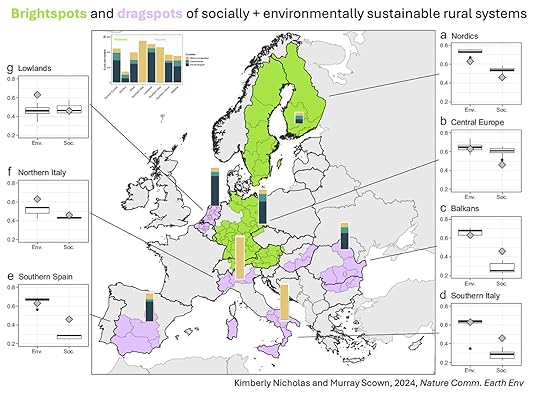 Two hotspots (green) and five dragspots (purple) of sustainable rural land systems in Europe, based on their performance on 24 social and environmental indicators. Dragspots tend to receive high CAP subsidies, yet deliver poor sustainability outcomes. The median and interquartile range (box) is compared to the mean score across all regions (grey diamonds). The inset shows subsides paid from the Common Agricultural Policy for income support (navy), environmental (green), or other (yellow) for each hotspot. Source: Figures 3 + 4 in Nicholas and Scown, 2024 The path forward
Two hotspots (green) and five dragspots (purple) of sustainable rural land systems in Europe, based on their performance on 24 social and environmental indicators. Dragspots tend to receive high CAP subsidies, yet deliver poor sustainability outcomes. The median and interquartile range (box) is compared to the mean score across all regions (grey diamonds). The inset shows subsides paid from the Common Agricultural Policy for income support (navy), environmental (green), or other (yellow) for each hotspot. Source: Figures 3 + 4 in Nicholas and Scown, 2024 The path forward Our research suggests the following steps to transition to sustainable food systems:
Measure sustainability using social and environmental outcomes tied to policy goals.
Shift subsidies to reward positive social and environmental outcomes.
Support low-input, sustainable farming for its multiple benefits.
Explore case studies where generous food production is balanced with good sustainability outcomes.
Read the study here, if you like.
Feelings: ResoluteI’ve been feeling… kind of a lack of feeling… about some pretty monumental events this fall: the American elections, the United Nations conferences on climate and biodiversity. These are important moments, things are not going great, and yet my response is… meh? 🤷♀️
Right now, I don’t feel panic or despair. I know climate work is still needed and it still matters. This will continue to be true for the rest of my life.
In what I hope is being resolute and clear-eyed and constructive, but may also be tinged with cynicism, I increasingly accept in my bones that no one is coming to save us. As I wrote in Under the Sky We Make,
We as humanity, a groundswell of people alive today around the world, have to save ourselves, through what we think and feel and ultimately what we do. This means we need people with the courage and compassion and imagination to transform themselves, and society, in the ways that science tells us are necessary to maintain conditions for life on Earth to be able to thrive. Each of us can become that sort of person; more and more are every day.
Real leadership - climate and otherwise- may not emerge from the top. In the past, I’ve felt shattered by global circumstances going in the wrong direction. Right now, I just feel resolute to keep doing what I can, where I can. Thanks for being on Team Climate.
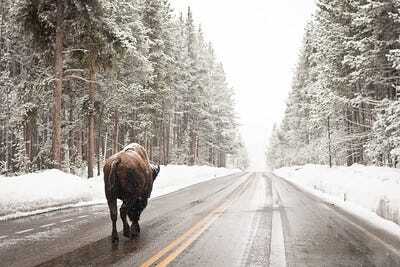 A resolute bison keeps putting one foot in front of the other. Image: Jess J on Flickr Action: Reassess Social Media
A resolute bison keeps putting one foot in front of the other. Image: Jess J on Flickr Action: Reassess Social Media Ah, social media, that double-edged sword.
On the positive side, social media can shape cultural norms and help set policy agendas, including for climate action. But social media can also spread climate misinformation (unintentionally incorrect) or disinformation (deliberately misleading), contribute to increasing polarization, and disproportionately amplify negative messages.
As a very active user of social media professionally, I’ve gained valuable connections, ideas, and community. But over the last couple of years, especially now that Climate Twitter has become, as Katharine Hayhoe told Science last week, a “ghost town,” I’ve been reconsidering how and when I use social media.
Instead of hot takes, I crave deeper, slower, more thoughtful and nuanced analysis and reflection. Reading more longform journalism and books, and spending more time in the real world (connecting with people, going for walks, paying attention while cooking) feels better for me right now.
 Source: Bayo Akomolafe, “A Slower Urgency”
Source: Bayo Akomolafe, “A Slower Urgency”I want to save the precious, limited bandwidth of my mind and attention for what matters and where I can make a contribution. Five years later, I’m still haunted by the hour-long yoga class I ruined by ruminating over a comment from A Stranger on the Internet Who Was Wrong.
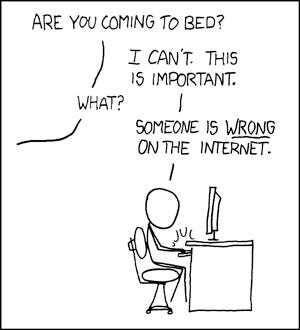 From the genius that is Randall Munroe, XKCD
From the genius that is Randall Munroe, XKCD I’m also increasingly uncomfortable with the idea of donating my unpaid labor - writing original material, as well as clicking on platforms - to further enrich billionaires with dubious motives.
My evolving strategy is to spend more time writing original longer “content” (cringe) here on Substack, sharing excerpts on social platforms, and slowly keep working on a new book.
I appreciate that you, dear reader, have chosen to join We Can Fix It and to share your email with me, so we can stay connected regardless of what happens to these platforms. So thanks for being here. <3
For your climate action this month, I encourage you to consider your relationship with social media.Some options to consider, to whatever extent works for you right now:
Remove social media apps from your phone.
Try a social media fast (a week? a month?).
Set time limits for apps using tools like Screen Time for iPhone or Digital Wellbeing for Android.
Follow those who spark your curiosity and energy. Block those who don’t.
Choose when and how you engage, and the kinds of conversations you want to contribute to.
Charge your phone outside your bedroom to avoid late-night distractions. (This has helped me sleep better and double the number of books I read!)
What will you do with the time and energy you free up? That’s up to you! A few suggestions:Take high-impact climate action with the Choose Your Own Climate Adventure Guide.
Enjoy time in nearby nature, and take care of your local patch.
Find your climate peeps — people you have fun with, including while talking about and taking climate action.
Join and support local climate action groups- here’s how to get started.
Read more books and in-depth journalism, like my recommended climate media.
Thanks for reading! Please share this post with a friend to spread climate action.
Parting Tidbits Upcoming talks:Join in person or online on December 12 for a seminar and workshop on sustainable agriculture in a changing climate, hosted by Université Laval in Quebec City.
 Book Recommendation
Book Recommendation Limitarianism: The Case Against Extreme Wealth, by Ingrid Robeyns. I really enjoyed reading this clearly argued book, making the philosophical case for setting an upper limit on wealth for the sake of people and climate. Definitely a thought-provoking holiday gift!
Take care friends, have safe and peaceful holidays. I’ll be back here in January, look forward to seeing you then!
xo,
Kim
P.S. I met my goal of 1,000 hours outside for 2024! Actually I’m ahead of schedule, I’m now at 1,125 and counting! I really enjoyed finding more ways to be outside, and hope to continue. Highly recommend for 2025!
This post is free to make climate action accessible to everyone. Please subscribe to receive new posts. If you find my work valuable and are financially able, I am grateful for any support you can give as a paid subscriber.
October 31, 2024
87.5% screwed
Hi friends!
This month, we’ll explore the safe and just space for humans on Earth; how to turn a gnawing rat of avoidance into a fluffy white sheep of possibility; and democratic principles for doing the work to build the world we want.
Facts: We’re 87.5% screwedWe’re in trouble: humanity has crossed seven out of eight global thresholds needed to keep Earth stable and provide a good life for all, according to the Earth Commission report. Eeek!
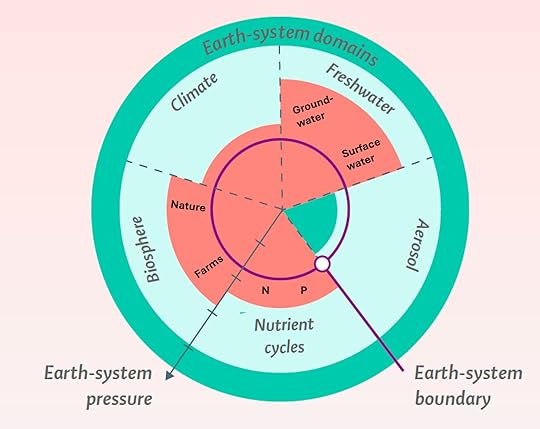 Current status of eight Safe and Just Earth System Boundaries, where seven of eight are in the red danger zone. Source:
Lancet infographic
based on Gupta et al., 2024. I added the boundary names in bold (e.g, N, P).
Current status of eight Safe and Just Earth System Boundaries, where seven of eight are in the red danger zone. Source:
Lancet infographic
based on Gupta et al., 2024. I added the boundary names in bold (e.g, N, P). Climate, groundwater depletion, surface water overuse, nitrogen and phosphorous pollution, land for nature, and natural vegetation within human-dominated landscapes are all in the danger zone. Only particulate air pollution (aerosols) hasn’t crossed global limits, though it’s over the line in some regions.
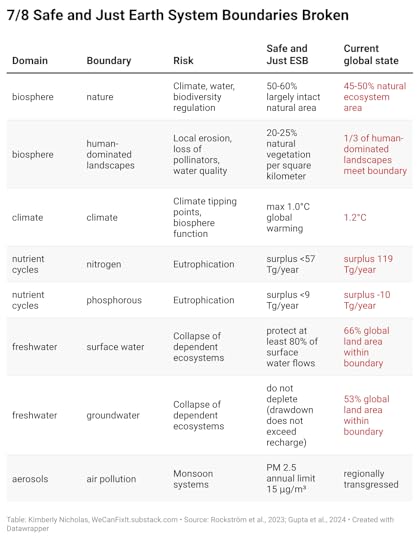 The eight Earth System Boundaries, the risks from breaking them, the safe and just boundary threshold, and the current global state. Boundaries over the limit are shown in red. Source: My own visualization from data in Rockström et al., 2023 and Gupta et al., 2024
The eight Earth System Boundaries, the risks from breaking them, the safe and just boundary threshold, and the current global state. Boundaries over the limit are shown in red. Source: My own visualization from data in Rockström et al., 2023 and Gupta et al., 2024This study builds on work dating back 15 years, including the inspiration for this gem:
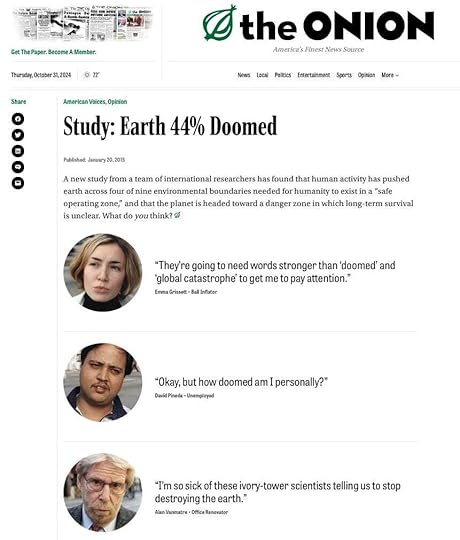 Possibly my favorite piece from The Onion, in response to the 2015 Planetary Boundaries study. Needs above the floor, pressure below the ceiling
Possibly my favorite piece from The Onion, in response to the 2015 Planetary Boundaries study. Needs above the floor, pressure below the ceiling Scientists created these “safe and just Earth System boundaries” by combining the planet’s biophysical limits (the ceiling) with meeting everyone’s basic needs (the floor).
The goal is the green zone, where all people have access to minimum needs for food, water, energy, and infrastructure, without putting too much pressure on Earth systems.
The just zone means sharing resources fairly among species (who all need a stable planet), across generations, and among today’s communities.
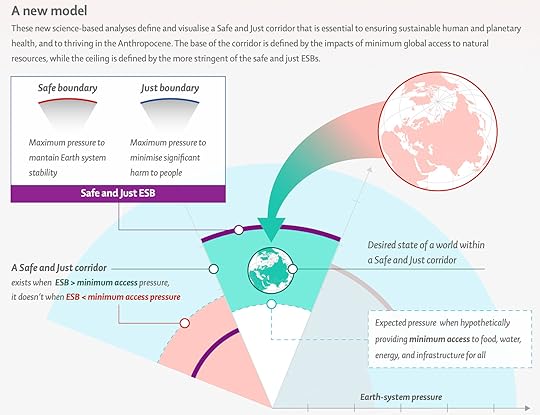 Safe and Just Earth System Boundaries are met when all people have basic needs met, within a stable Earth system. Source: Lancet infographic based on Gupta et al., 2024. Solutions: Reduce and redistribute; align the economy with justice; expand sustainable tech
Safe and Just Earth System Boundaries are met when all people have basic needs met, within a stable Earth system. Source: Lancet infographic based on Gupta et al., 2024. Solutions: Reduce and redistribute; align the economy with justice; expand sustainable tech To get to the safe and just space, the Earth Commission suggests three main solutions:
Reduce and reallocate consumption: cut waste and set limits on harmful overuse, while ensuring everyone has what they need.
Transform the economy: Align markets with sustainability and justice by factoring in environmental costs, and stopping harmful subsidies and investments.
Expand sustainable tech: Make efficient, affordable tech available worldwide to create a circular, low-impact economy.
P.S. I’m working on solutions that will get us to the Safe and Just space- stay tuned!
Feelings: “Befriend your gnawing rats”You know the things you’re avoiding because they make you anxious to think about? Like the cluttered garage you never get around to cleaning… or the nagging health concern you keep putting off… or, you know, taking meaningful climate action??
The wise-but-not-treacly Oliver Burkeman, in Meditations for Mortals, has great advice for facing these stressors, borrowing a vivid metaphor from Paul Loomans, who calls them “gnawing rats.”
Instead of the usual advice to attack the problem head-on, or break tasks into smaller parts, Burkeman advises to start by accepting the rats’ existence.
It’s a gentler approach based on accepting reality as it already is, and turning towards the gnawing rats:
Some ways to befriend your gnawing rats, thanks to Burkeman:
“[T]o befriend a rat is to defuse the anxiety you feel by transforming the kind of relationship you have with it… You turn it into an unobjectionable part of your reality. Whereupon a gnawing rat, in Looman’s terminology, becomes a ‘white sheep’— a harmless, docile, fluffy creature that follows you around until you decide to do something about it.”
—Oliver Burkeman, Meditations for Mortals
Take the easiest step forward: Find the least intimidating way to begin.
Ask for help: Your gnawing rats may be someone else’s harmless white sheep- and they likely have some of their own rats you could help them with.
Visualize getting started: Close your eyes and picture yourself taking action.
“Just go to the shed”: Visit the space that’s making you anxious and guilty, have a look around, and let the first solutions reveal themselves.
Do something you can actually do today: If an hour of work sounds overwhelming, could you tolerate half an hour? 15 minutes? 10?? (At my low point in writing my dissertation, I had to start with 10-minute writing sessions. It did eventually get written. I also like to set a 5 minute timer to start a task I don’t wanna do; usually I have enough momentum to continue from there once I’ve started.)
What small step could you take today to start befriending one of your gnawing rats?
P.S. Remember the 5 Stages of Climate Feelings— avoidance is #2, and the way from Doom to Purpose is via All the Feels!
Action: How to Organize DemocraticallyThere’s a lot of important and urgent work to do. How do we work well within teams and communities to make lasting progress?
Thankfully, nearly 30 years ago, environmental justice leaders developed the Jemez Principles for Democratic Organizing, which can help us organize in a fair, inclusive, and effective way. Here’s a brief summary:
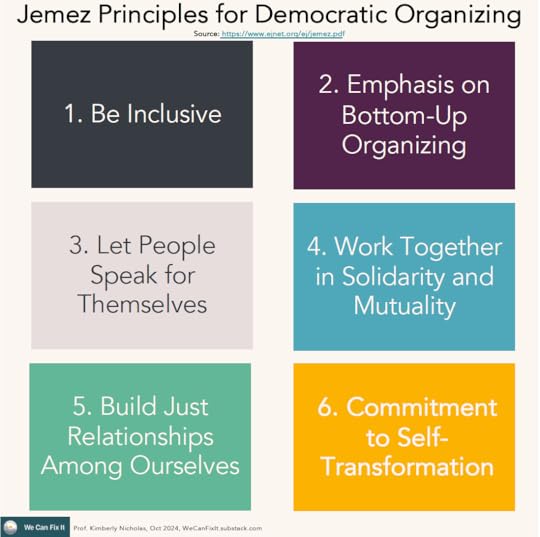 The Jemez Principles of Democratic Organizing. Source: https://www.ejnet.org/ej/jemez.pdf Jemez Principles for Democratic Organizing
The Jemez Principles of Democratic Organizing. Source: https://www.ejnet.org/ej/jemez.pdf Jemez Principles for Democratic Organizing (This is a selected summary; full text here.)
1. Be inclusive.Build inclusion into your movement, going beyond tokenism to include diversity throughout planning and action. It might take more time and effort, but it’s essential.
2. Emphasis on Bottom-Up OrganizingReach out to new groups, and strengthen your existing base. Building a strong grassroots foundation gives your movement credibility, strategy, and “the energy for the work we must do daily.”
3. Let People Speak for Themselves“We must be sure that relevant voices of people directly affected are heard.” Community spokespeople should be genuine representatives. Assure accountability.
4. Work Together in Solidarity and MutualityCollaborate with groups whose visions align with yours, and support each others’ work. Ultimately, integrate their goals and values in your own work. For example, a labor union including environmental goals in their own strategies, rather than just supporting environmental organizations.
5. Build Just Relationships Among OurselvesTreat everyone with respect and fairness, within and across organizations. This includes being transparent about decisions, sharing resources, and ensuring equitable strategies.
6. Commitment to Self-Transformation“We must ‘walk our talk.’ We must be the values that we say we’re struggling for.”
What parts of your work could benefit from these principles? Have you found other effective ays to run fair and inclusive processes? I’d love to hear your thoughts- feel free to share n the comments below, or by reply to this email!
Thanks for reading! Please share this post with a friend to spread climate action.
Parting Tidbits Upcoming talks, come see me here:Extreme Wealth and Climate Inequality: If you’re in Lund, join us on November 20th at 18:00 for a lecture from philosophy professor Ingrid Robeyns and discussion panel on her new book “Limitarianism: The Case Against Extreme Wealth.”
Recent podcast:I discussed what the US election means for global climate, and answer listener questions about China’s emissions and 1.5°C. Listen from 18:00-27:30:
Book Recommendation:American Mermaid, by Julia Langbein. A wild and surreal novel about staying sane and principled in a world that increasingly isn’t. Felt pitch-perfect for this moment. I want to live in a world where fierce mermaids take on evil technocrats destroying the climate!
Thanks for reading. Take care, friends!
xo,
Kim
This post is free to make climate action accessible to everyone. Please subscribe to receive new posts. If you find my work valuable and are financially able, I am grateful for any support you can give as a paid subscriber.
September 26, 2024
Why leaders fail to lead by example on climate
Welcome to We Can Fix It, where we tackle the climate crisis with facts, feelings, and action. Written by me, climate scientist Kim Nicholas.
Hi friends!
This month, I have a new study for you on how inertia from the top locks in high-carbon lifestyles. We’ll embrace mixed climate emotions like feeling glad + sorry at the same time. Plus, learn how to get started with climate action by taking inspiration from penguins, not wolves.
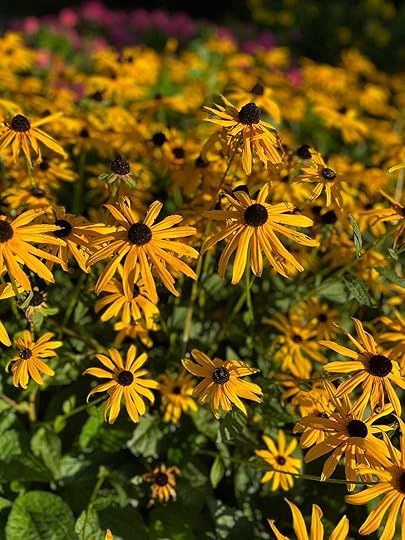 Fun fact: Each of these “flowers” is made up of hundreds of ray and disk flowers! Asteraceae in Lund Botanical Garden. Photo: me Facts: Why leaders fail to lead by example
Fun fact: Each of these “flowers” is made up of hundreds of ray and disk flowers! Asteraceae in Lund Botanical Garden. Photo: me Facts: Why leaders fail to lead by exampleDespite public support for climate action, many politicians avoid leading by example. A study led by Steve Westlake, interviewing 19 UK Members of Parliament (MPs), found two main reasons:
(1) Support for high-carbon norms: MPs promote high-carbon lifestyles as the accepted social standard.
(2) Fear of moral judgments: MPs worry leading by example will be dismissed as hypocrisy or virtue signaling.
Reinforcing high-carbon norms
“MPs are part of a systemic resistance to transformative low-carbon behaviour, thus sustaining high-carbon norms and slowing the climate transition.”
—Steve Westlake, Twitter thread
MPs’ responses indicated:
They justify their own inaction by citing fairness concerns for low-income constituents [who already have low carbon footprints], but ignore the high-carbon lifestyles of the wealthy [who do need to reduce overconsumption].
While appealing to social justice sounds good, it ignores enormous differences in emissions based on wealth. MPs, who are wealthier and likely to lead high-carbon lifestyles, misleadingly focus on low emitters.
While MPs claim it would be unfair to demand change from the less privileged, interviews showed that “the consumption habits of the wealthy are not problematized or discussed in relation to climate change.”
MPs also framed low-carbon behavior as “extreme” or “radical”, and cited a lack of demand from constituents for their personal leadership. They preferred incremental change or hypothetical technological solutions that wouldn’t threaten high-carbon industries or require behavior change.
Fear of moral judgmentsMany MPs view leading by example as risky, fearing attacks by rivals, the media, or social media. Only two MPs publicly shared their low-carbon actions, citing the importance of positive role modeling. Most worried their credibility would suffer and feared accusations of bragging, virtue signaling, hypocrisy, or seeming “too saintly”.
Thus MPs worried about “appearing too moral, rather than being perceived as having a lack of morality.”
Westlake et al. found that “morally laden language was not used by any MPs in relation to high-carbon behaviour, indicating that it is low- rather than high-carbon behaviour that risks moral transgression.”
In sum: MPs fear public reaction to their personal behavior more than they fear failing to address high-carbon lifestyles. But addressing the top 10% of emitters is crucial, because they cause 50% of household climate pollution globally.
Why norms and culture matter to system changeBreaking carbon lock-in will require addressing three key elements:
Better infrastructure
Policies that reward low-carbon living
Social norms that make low-carbon action desirable.
If any element is missing, it hinders progress. This study reveals how leaders reinforce a high-carbon culture through upholding high-carbon norms.
But there is a way out. In a forthcoming study, Westlake shows that “leading by example increases public willingness to adopt low-carbon behaviors [and thus, to accept effective climate policies], and increases leader credibility and approval.” Stay tuned!
Feelings: Mixed emotionsLiving in the climate crisis means tolerating mixed emotions. Life throws a lot at us, and we can feel torn, conflicted, or many feelings at once.
There can be strength in mixed emotions; behavioral science researchers discuss “the power of ambivalence” in authentic leadership.
One mixed climate feeling might be called glorry (glad + sorry)— glad we’re not alone in tough climate emotions, and sorry others are struggling too.
There’s power in knowing you’re not alone, even if you wouldn’t wish a difficult experience on anyone.
Remember, riding the waves of “all the climate feels” is the bridge from doom to purpose.
 Glorry = Glad we’re in this together + Sorry you’re going through this too. Inspiration for a cake with mixed emotions from Jennifer Weiner. Image: Dall-E3
Glorry = Glad we’re in this together + Sorry you’re going through this too. Inspiration for a cake with mixed emotions from Jennifer Weiner. Image: Dall-E3 Jennifer Weiner perfectly captures mixed emotions:
“My mom died early on a Sunday morning — Mother’s Day, the day before my daughter’s 18th birthday. I bought a cake, and the birthday girl used frosting to divide it into thirds and write Happy Birthday/Happy Mother’s Day/Sorry for Your Loss. It felt like life: good and bad overlapping, everything, all at once.”
-Jennifer Weiner, “First, I Cried. Then, I Rode My Bike.”
P.S. A comment from We Can Fix It reader Divya inspired me to name this emotion. Thank you, Divya!
Action: Be a climate penguin, not a wolfTeam Climate is growing, hooray! Every day, more people wake up to the urgency of the climate crisis. But many struggle to harness their energy effectively.
The best way to get involved is to join an existing local group. (Here’s how, from your personalized climate action guide!)
Smart people in your area have spent years building campaigns and relationships, and analyzing strategies. The best way you can have an impact and build skills is to join them.
Think of penguins huddling together, sharing responsibilities to survive harsh conditions. It’s cozier and more fun than going it alone.
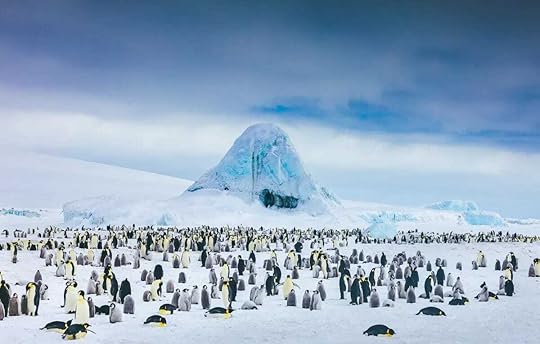 There’s strength in numbers. Image © David Merron/Getty
There’s strength in numbers. Image © David Merron/GettyJamie Margolin’s guide for getting started includes six steps:
Find an organization, political campaign, or community group.
Get their contact info from their website or social media.
Write or call them, explaining you’d like to get involved and why.
Just take the leap and join a meeting, attend an event, and take it from there.
Be open to learning by doing.
Figure out your why.
-Condensed from Jamie Margolin, Youth to Power: Your Voice and How to Use It
When you’re reaching out to new people, make it easy for them to say yes! Write short, tailored emails with specific requests. Focus on aligning with their goals rather than making it about you. Existing groups want to grow, so it’s a win-win.
Don’t be a Climate Lone WolfWhat doesn’t work: coming up with a solution alone and imposing it on others without building relationships or strategy. This is counterproductive, causing burnout and yielding no effective action.
I often get emails from lone climate wolfs like this:
“Hello, we’ve never met, and I don’t have climate experience, but I watched this YouTube video and decided nuclear power is the solution. I’ve written a letter I want you to sign/ developed a product I want you to endorse. I’ve contacted organizations I’m not part of, asking for support, but they haven’t responded.”
See the problem? The lone wolf hasn’t built trust or relationships, and hasn’t learned others’ goals. The focus is too much on them personally (the word “I” appears seven times).
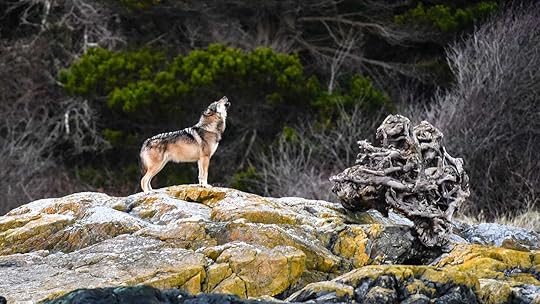 A lonely lone wolf. Image: CBC, The Nature of Things
A lonely lone wolf. Image: CBC, The Nature of Things Yes, we need fresh ideas and energy in the climate movement— but also humility and collaboration.
P.S. If you’ve already attended lots of local meetings, and still see a gap that needs filling, you just might be ready to start your own organization. Jamie Margolin’s guide to “Movement and organization building 101” is in Chapter 4 of Youth to Power.
Thanks for reading! Please share this post with a friend to spread climate action.
Parting Tidbits Recent podcasts: Climate disinformationI joined the EcoLitACT podcast to discuss understanding and fighting climate disinformation (starting 34:40), my thoughts on carbon removal (56:14), and a turning point in my career (10:17). Have a listen:
Book RecommendationDoughnut Economics, by Kate Raworth. This book lays the foundation for the modern view of sustainability: providing a good life for all within the planet’s limits. It’s an ambitious but accessible call to rethink almost everything to build a better life on Earth.
xo,
Kim
This post is free to make climate action accessible to everyone. Please subscribe to receive new posts. If you find my work valuable and are financially able, I am grateful for any support you can give as a paid subscriber.
August 29, 2024
Climate Citizens, Unite!
How to seize the climate moment in the biggest election year on Earth; we know what it takes to reverse biodiversity loss; being a “half-hearted fanatic” for climate
Hi friends!
I’m slowly adjusting to sitting in front of a keyboard again, after a glorious summer of sailing, paddling, swimming, reading, and talking to old friends around a campfire. Very happy to report I’m at 871 hours outside so far in 2024, which has done wonders for my soul. You can join the challenge to spend 1,000 hours in a year outside at any time, as my friend Emily just did!
I’m still finding my way amidst a tough year personally, but I’m grateful to report my health is much better, and I feel my cup is filled and I have some energy to give.
I hope you got to spend time with loved ones and with beautiful nature this summer!
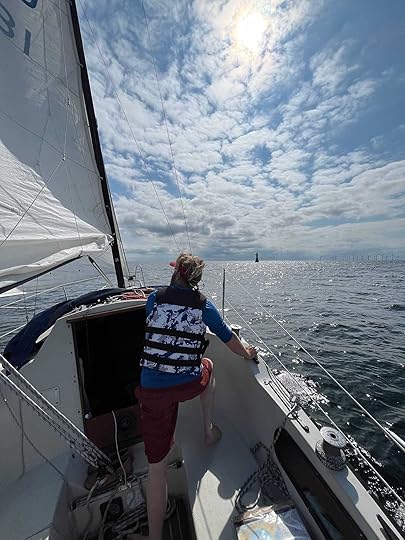 Simon and I having fun in the Öresund!
Simon and I having fun in the Öresund! As all the Swedish signs say, “Finally, back to the everyday,” so here comes your monthly dose of facts, feelings, and action for facing the climate crisis together with our lovely We Can Fix It community and me, your trusty climate scientist!
Facts: How to Save Life on EarthI’m working on a new project I’m excited about. Here’s a sneak peek. I hope you enjoy!
Reading the news about precipitous declines in species and ecosystems feels overwhelming. Humans are rapidly wiping out life on Earth. Humanity has cleared almost 40% of forests globally. Only 15% of the original biomass of all wild land mammals remains.
But! The destructive trends don’t have to continue.
We know how to save biodiversity.A study led by David Leclère found that we can stop worsening the ongoing trend of global biodiversity loss by doing three things:
Increase conservation with land protection and management;
Restore degraded land; and
Plan for conservation across landscapes to connect and increase ecosystem resilience.
These three strategies together will prevent about half of future biodiversity loss (yellow line below).
 Conservation alone (yellow) can stop the further loss of biodiversity; adding sustainable food consumption and production can restore biodiversity (green). Source: Leclère et al., 2020.
Conservation alone (yellow) can stop the further loss of biodiversity; adding sustainable food consumption and production can restore biodiversity (green). Source: Leclère et al., 2020.To actually reverse biodiversity loss (green line above), Leclère and colleagues found we’ll have to do three more things:
Cut food waste in half throughout the supply chain globally;
Eat more plant-based diets in areas where meat consumption is too high for health and environmental sustainability, like the US and Europe, where animal product consumption should be cut in half; and
Increase agricultural productivity per unit of land, and increase trade to get food from where it’s best produced to the people who need it.
Land conservation & plant-based diets are most effectiveOf these six measures to restore life on Earth, by far the most effective was conservation. Better protecting and managing land (Measure #1) was about five times more effective for reversing biodiversity loss than the supply-side measures of increasing agricultural intensification plus trade (Measure #6).
News flash: Starting at the root to prevent problems is much more effective than treating their symptoms!
The typical focus is on increasing production, but demand-side solutions are far more effective. (In a study I coauthored analyzing over 12,000 studies on how to feed the world, we found three-quarters of the literature focused on increasing food production, while only a quarter focused on right-sizing demand per capita).
Combining demand-side solutions by halving food waste (#4) + halving animal consumption with more plant-based diets (#5) was twice as effective to reverse biodiversity loss as the supply-side solutions to increase yields + trade (#6).
 Land conservation (C, measure 1, green line) and Demand-side solutions (blue line = food waste (4) + more plant-based diets (5)) are the most effective solutions to reverse biodiversity loss. Source: Leclère et al., 2020, Nature.
Land conservation (C, measure 1, green line) and Demand-side solutions (blue line = food waste (4) + more plant-based diets (5)) are the most effective solutions to reverse biodiversity loss. Source: Leclère et al., 2020, Nature. Overall, reversing biodiversity loss and rebuilding the ecosystems and communities where plants and animals can thrive is possible- and essential.
More good news— we also know what land to protect, and it’s concentrated in a few areas. Maybe I’l write more about that soon. :)
Feelings: Embrace Half-HeartednessI’ve been talking with friends about a new feeling I’m experiencing. Belinda calls it “mediocrity is the goal.” Denise calls it “not resisting a new chapter.” Rahul calls it “half-heartedness,” after the Edward Abbey quote below:
“Do not burn yourselves out. Be as I am - a reluctant enthusiast....a part-time crusader, a half-hearted fanatic. Save the other half of yourselves and your lives for pleasure and adventure. It is not enough to fight for the land; it is even more important to enjoy it. While you can. While it’s still here. So get out there and hunt and fish and mess around with your friends, ramble out yonder and explore the forests, climb the mountains, bag the peaks, run the rivers, breathe deep of that yet sweet and lucid air, sit quietly for a while and contemplate the precious stillness, the lovely, mysterious, and awesome space. Enjoy yourselves, keep your brain in your head and your head firmly attached to the body, the body active and alive, and I promise you this much; I promise you this one sweet victory over our enemies, over those desk-bound men and women with their hearts in a safe deposit box, and their eyes hypnotized by desk calculators. I promise you this; You will outlive the bastards.”
-Edward Abbey, Desert Solitaire
I have many friends currently in the depths of or slowly recovering from burnout. (I wrote about addressing the root causes of burnout a couple years ago). Working for climate is tough. At our work kickoff last week, our director said, “Our normal job can suck the life out of us.” We have to resist that life-sucking spiral.
This idea of setting limits on even urgent and important work, to have time and energy to prioritize health and relationships, pleasure and adventure, and ultimately stay in this work for the long haul is resonating with me right now.
What do you think?
P.S. On the other hand, Derrick Jensen wrote that he “always kind of hated [this Abbey] quote.”
Action: Climate Citizens, Unite!As you know from the Choose Your Own Adventure Climate Action Guide, if you live in a democracy, your most powerful climate superpowers are as a citizen.
And 2024 is a BIG year for climate citizens.
According to the United Nations Development Programme:
This is the biggest election year in human history. Half of the world’s population – some 3.7 billion people – will have the opportunity to go to the polls in 72 countries.
Here are some of your top actions as a climate citizen. Please roll up your sleeves and get to work!
Your #1 climate action as a citizen is to vote for leaders who'll make and implement strong climate policies.Your vote can have up to 3x the climate impact of your carbon footprint, based on the policies your elected officials enact.
There are important climate policy issues on every ballot, in national, regional, and local elections.
To vote for climate:
Make sure you're registered to vote in your next election. If not, sign up at a trusted government website (like this one, to Register to vote in the US) or from searching "register to vote" + "[name of my country]".
After you've registered to vote, note on your calendar the date of upcoming elections, and set a reminder to vote. Find upcoming elections in the US (the general election is November 5, 2024).
Be sure to vote in primaries and local elections as well as national elections.
How can you find politicians committed to real climate action?Elect politicians with good climate voting scores from organizations like LCV in the US or the Climate Action Network in Europe.
If your candidate doesn't have a score--vote for candidates who have pledged not to take fossil fuel money.
Check who funds your candidate (hint: big fossil fuel companies are not great for ambitious climate policy).
And please, for lots of reasons including the climate, elect more women! A 2019 study showed more women in parliament resulted in lower national carbon emissions via stronger climate policies.
Give time and money to climate politics organizationsA study led by Seth Wynes on the climate impact of voting had some important tips:
If you have money to spend on climate action, don’t buy offsets. Donate it to politicians running on a strong climate platform, especially supporting scrappy challengers against incumbents with a bad climate voting record early in the election cycle in close races.
A good option for non-wonks who don’t follow every race is “giving to organizations who aim to elect climate-concerned legislators and relying on their expertise to allocate funding.”
Wherever you give, openly discussing your contributions is important, because research shows this type of giving is contagious.
Here are a few great climate-focused organizations that could really use your support to help elect climate champions:
“The Environmental Voter Project identifies millions of non-voting environmentalists and turns them into consistent voters.” The group estimates that 13,000,000 environmentalists don’t vote in federal US elections. Mobilizing this group who already cares about climate to vote their values is incredibly powerful. (Every US Presidential election since 1984 has been decided by fewer votes than that.) They’re looking for volunteers to call potential voters, send postcards, or knock on doors to mobilize these inactive environmental voters.
Climate Power’s communications are “localizing and personalizing the impacts of climate progress being made right now — from local hiring, to lowered energy bills, to cleaner air and water”. They have helpful resources for key swing states on how to talk to voters about the benefits of current climate policies, as well as how climate impacts are harming local people and places.
Climate Cabinet helps “high impact leaders run, win, and legislate on climate change.” They score US state legislators for their climate and environmental justice records, and focus on the “500,000 state and local elected officials [who] control 75% of US emissions.” You can donate to support the “downballot races with the biggest climate impact.”
I’d love to hear about your favorite climate policy organizations and how you’ve been involved- especially those beyond the US. What organizations have you supported and why? Please let me know in the comments below!
Parting Tidbits Upcoming talks, come see me here:I’ll be lecturing on effective personal climate action at Lomma Library at 18:30 on September 4. Welcome to join!
Recent podcast:Just two Swedes chatting climate— here’s me in conversation with Tarzan (Alexander Skarsgård) on how to get beyond analysis paralysis and focus on what choices really matter for climate.
Book RecommendationInto the Clear Blue Sky: The Path for Restoring our Atmosphere, by Rob Jackson. I heard Rob give an inspiring seminar at Stanford about his “crazy dream”— that humanity should not just stop climate getting worse, but actually restore it to its full pre-industrial splendor. In this book he shares his vision for moving from “climate despair to repair.”
Thanks for reading!
xo,
Kim
This post is free to make climate action accessible to everyone. Please subscribe to receive new posts. If you find my work valuable and are financially able, I am grateful for any support you can give as a paid subscriber.
June 28, 2024
Low-carbon summer
Welcome to We Can Fix It, where we tackle the climate crisis with facts, feelings, and action, written by me, climate scientist Kim Nicholas.
Hi friends!
I’m still working with limited capacity due to grief and some health issues. But I wanted to send this newsletter to share some news I hope you can use, and to say I’m grateful for the work you’re doing for climate, and for your kind support over these last months. Please hang in there and take care of each other!
Facts: Climate AccountabilityLast month, I attended the Swedish Climate Symposium and heard an excellent talk by Prof. Åsa Persson, Chair of the Swedish Climate Policy Council. (That’s a group of scientists who evaluate how well our government is doing on meeting national climate goals.)
Åsa made many smart observations on the current climate policy landscape:
We’re moving from the age of
climate action (acknowledging the need to act) →
to climate ambition (announcing targets) →
to climate accountability (implementing policies and practices that deliver emissions reductions and meet targets).
The initial focus after the Paris Agreement was adopted in 2015 was pledges, with the goal to bring actors onboard. It was a low threshold; any target was welcome.
Now we’re in an era of scrutinizing government and corporate targets, and developing standards for what constitutes a good target.
Targets are usually politically easier to adopt than policy instruments, because targets don’t assign responsibility, allocate costs, or have to be completed within the current term of office.
Policy instruments (like taxes, subsidies, regulations, standards, information, public goods) usually assign responsibility and imply distribution of costs and benefits, which motivates actors to mobilize (including resistance).
What will enforce the Paris Agreement are implementation plans. Countries should adopt redistributive climate policies to build social acceptance.
The climate transition should be both
just (leaving no one behind, including fossil fuel workers and frontline communities) and
orderly (avoid delays from poor coordination, do things in the right order, follow a pace of change that balances costs and benefits over time and gives actors time to adapt).
To deliver climate targets in reality, Åsa proposed a climate “accountability ecosystem,” with important roles for evaluation, audit, and assessment of climate progress, as well as input from the public and civil society, scientists, and the media. I’d say you’re part of this ecosystem as a We Can Fix It reader, so thank you!
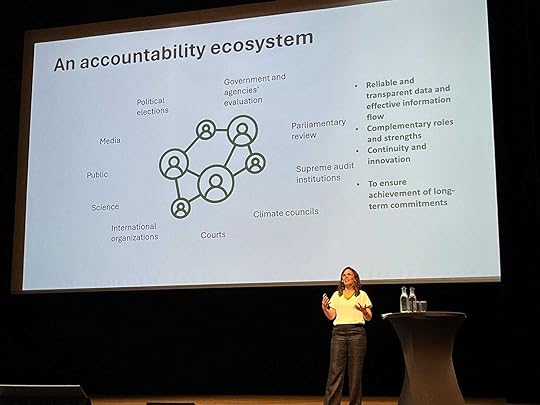 Prof. Åsa Persson’s keynote, Swedish Climate Symposium, May 2024. Photo: meFeelings: Tikkun Olam
Prof. Åsa Persson’s keynote, Swedish Climate Symposium, May 2024. Photo: meFeelings: Tikkun OlamI recently learned of two concepts from the Talmud that really resonated for me, thanks to social justice advocate Sim Kern on Instagram:
Tikkun olam, action to repair the world.
As Sim describes it, this is the view that our purpose is healing ourselves and the world.
“You are not obligated to complete the work, but neither are you free to abandon it.”
As Sim points out, this means that you can focus your energies where you feel they make the most difference, because so many others are also working to heal different parts of the world.
To me, this combination is really powerful. We have an essential purpose that matters to ourselves and others. It acknowledges that the work can be hard, and it may not be done in our lifetimes, but it’s still worth doing.
You can watch Sim’s full video here:
sim_bookstagrams_badly A post shared by @sim_bookstagrams_badlyAction: Low-carbon summer adventure
A post shared by @sim_bookstagrams_badlyAction: Low-carbon summer adventureSummer means longer days and perhaps time for vacation. It’s a great time to get outside. (I recently passed 500 hours outside so far in 2024, hopefully on my way to 1,000 hours outside for the year.) And it's a great time to enjoy some of the simple pleasures of life.
Your action this month is to enjoy some low-carbon fun, relaxation, and adventure. (This means reducing flying and driving as much as possible.)
Some ideas:
Get a summer transit pass and explore your local area. You could pick a theme to visit like excellent hikes, breweries, or cardamom rolls (just to name a few faves!)
Try a new activity that’s powered by your body (like biking or standup paddleboarding) or the wind (like sailing, which Simon and I are learning from scratch after we bought a 1976 Maxi 77 sailboat last year).
Grow something you’ll enjoy to eat or to look at in your garden or windowsill. This summer I’m enjoying growing and arranging flowers in memory of my mom.
Visit a local farmers’ market and collect treats to have at a picnic in the park.
Go to a local beach, lake, or pool and take a dip.
Keep it simple! As I wrote in Under the Sky We Make, “A lot of changing your life for the sake of the environment means trying way less hard, not more. British researchers identified activities to live better and happier while consuming and emitting less; they found the best win- win leisure choices are local outdoor activities, reading, hobbies and games, music, and— lowest emitting of all—“sleep and rest.” Science says: more naps!”
For tips on how to connect with and care for nature nearby, see my April 2021 post “A hot date with Planet Earth.”
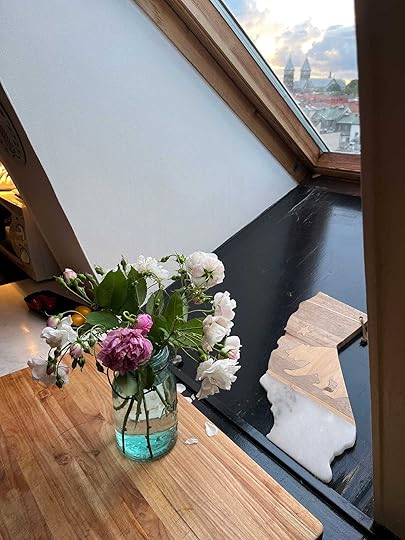 Roses from our garden, vase from my grandma, CA cheese board from my sister
Roses from our garden, vase from my grandma, CA cheese board from my sister Thanks for reading! Please share this post with a friend to spread climate action.
Parting TidbitsI spoke with Josh Spodek about my flying less journey, and why cultural change is essential to climate action, on This Sustainable Life podcast:
Book Recommendation:Not the End of the World, by Hannah Ritchie. I recently recommended this book to a high school science teacher for her science class. It’s a very good, accessible overview of not just environmental problems, but also where we’ve made progress and what more we can do.
I’ll be taking holiday in July, so I’ll see you back here in August. Thanks so much for reading.
xo,
Kim
We Can Fix It is a reader-supported publication. To receive new posts and support my work, consider becoming a free or paid subscriber.
May 31, 2024
Choose Your Own Adventure: Climate Action
I’ve compiled scientific research on effective climate action. Answer a few questions, and I’ll recommend the specific, highest-impact actions you can take.
Action: Choose Your Own AdventureHi friends,
It’s time to share something I’ve been working on for a really long time. It’s a personalized, interactive guide to high-impact climate action. A Choose Your Own Adventure: Climate Action edition, if you will.
I’m sharing it here first, for you, my lovely readers. I would love for you to test it out and share your feedback!
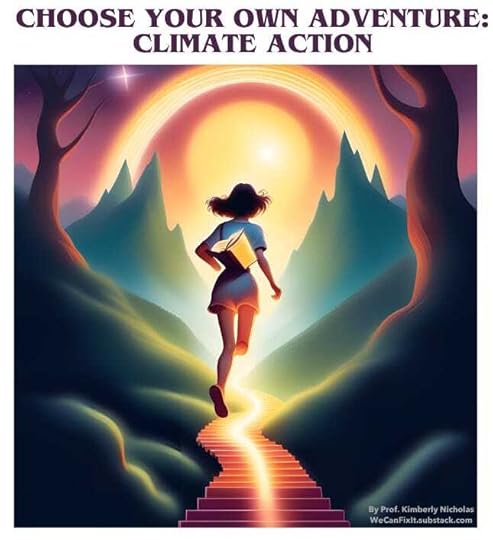 My new climate action guide, as depicted by Canva AI. What makes this guide different?
My new climate action guide, as depicted by Canva AI. What makes this guide different?It’s based on research quantifying the most effective, high-impact climate actions.
It's not about doing a million small things, hoping that "every little bit helps.” Rather, it's about identifying the few big things where research shows your actions can substantially move the needle.
It personalizes its guidance based on your answers, so you’ll automatically be directed to the next specific action you should take to have the biggest impact. No more analysis paralysis.
It focuses on the actions you can take that are most likely to contribute to system change, while also maximizing the emissions you reduce here and now.
It goes beyond just your carbon footprint to include your 5 Climate Superpowers- as a citizen, professional, investor, consumer, and role model.
It includes feedback from you, We Can Fix It readers, from a survey and your comments on what you most need to focus your limited time and energy on doing what really matters for the climate. Thanks for all your input so far- please check it out and let me know what you think!
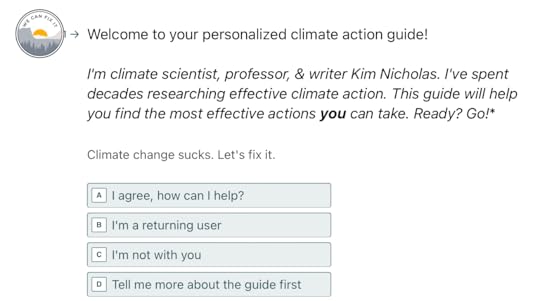 The adventure awaits! Click on the images above or here to try the guide.Feelings: Gratitude 🙏
The adventure awaits! Click on the images above or here to try the guide.Feelings: Gratitude 🙏I’ve been floored by your responses to my last couple posts, where I shared that my mom died, and that I’m still riding the waves of grief. It has meant so much to me to hear your kind words and support. I feel so grateful to share the humbling and unsettling experience of loss with so many wise and good people. And I feel encouraged to be on Team Climate with so many people who are working so hard both to heal the climate, and take care of each other.
Some of my favorite responses:
“Take the time you need, we’ll be here.”
“I appreciate your honesty in sharing your loss of your mom. I’m going through a loss [from yesterday to 30 years ago]. I can relate to what you write. It makes me feel less alone.”
“It’s okay to pass the baton and to rest. You’ve done work in the past that others who have energy right now can use and carry forward.”
“I ran a workshop last month based on some of your work, and it went great!”
Thank you, thank you, thank you. ❤️
xo,
Kim
Thanks for reading! Please share this post with a friend to spread climate action.
We Can Fix It is a reader-supported publication. To receive new posts and support my work, consider becoming a free or paid subscriber.
April 25, 2024
Riding the waves of grief
Hi friends,
I last wrote you here two months ago, a hasty note on my way back to California after my mom’s sudden death. Last month, on the day this newsletter normally goes out, I was instead helping to host my mom’s memorial service. Today I find myself back in the office, looking out the window at blue skies and trees bursting into life, with birds singing to welcome spring. I am back at work, but not back to full capacity, and definitely not “back to normal,” or back to who I was before my mom died. So this will not be a normal newsletter.
I am not usually short on words, but I find it really hard to put my current thoughts and experiences navigating grief and my profession into words. But here goes.
Honestly right now, I don’t care about climate change. It feels irrelevant, distant, and impersonal, and I am focused on my immediate experiences. Right after my mom died, my focus shrunk to an almost unbelievably tiny pinprick. I could not conceive of any future, could not make decisions or plans beyond the immediate moment. Drink this mug of coffee Simon placed in front of me. Go for a walk because the sun is shining.
One afternoon, I asked my dad what he’d like for dinner that night. He replied, “I don’t know, it’s too far away.” That perfectly summed up how I was feeling. It took my complete and full bandwidth just to get through the current moment, every single moment.
Over time my focus and attention span has gradually expanded, so I am now able to make plans for the coming weekend, and to look forward to good things in the future: getting our sailboat ready for our first full season on the water; planting seeds in the garden and looking forward to harvesting carrots in 16 weeks.
But I still cannot really muster the energy to care about the world at large. I have completely avoided the news until now. I have no idea what is going on in all the corners of the world that are not currently inhabited by me or my family. I have deleted social media from my phone, and barely logged in on my computer. I just don’t have the spoons.
It is surprising to me how little I feel bothered by my inability to do more right now. A huge and important part of my life and my identity has been poured into caring about the world. My passion for abstract ideals like Nature and Fairness, and my desire to protect people and places I love, has fueled me to fight climate change. This passion has felt like not just a job or a career but a calling. It propelled me between Madison, Stanford, Sonoma, Davis, and Sweden. It inspired me to study the changes to the Earth that climate change was causing, and to become more and more involved in speaking and writing about these in a way I hoped would motivate others to care, and to help do the work necessary to protect what they loved. But right now, it is too hard.
Part of me wonders if this inward focus is how it’s always been for “everyone” else. That the tiny details of my own life feels so much more important and real to me than anything of global and lifetime-spanning significance, but doesn’t feel like it’s happening right this very minute, to me [reader, I’m talking about climate change]. It feels selfish and fabulous.
I’ve reflected on my privilege. Until now, I’ve had the bandwidth to focus so much on taking care of the wider world because my family and I were already so well taken care of. We never had to worry about basic needs like food and water and shelter (except when my family was evacuated during the wildfires and worried their homes would burn down). I’ve largely enjoyed very good health, though that’s something I’m not taking for granted right now. I’ve had far more than my fair share of luxuries.
I have learned so much in these last two months. Most of all, this time has been incredibly humbling. I can feel, really viscerally feel, how small I am. Usually I have the feeling that I have agency in the world to exert my will. I try to make a difference, of course in a direction that I think is right and good. But right now I don’t feel like that.
As I texted a friend, “I’m practicing sitting with many feelings. One takeaway I’ve felt since my mom died is that the idea of me as the agent in charge of my life is an illusion and I am a tiny leaf borne by much bigger tides of the universe. Surrender is a new thing for me but it’s been feeling positive, relieving rather than disempowering. Apparently growth happens from challenge who knew lol.”
I know I am just at the very beginning of navigating the unmapped territory of grief. I know that no feeling is final, and how I feel tomorrow or next week or month or year may be entirely different than how I’m feeling today. In a few weeks I may regret or not recognize these words. Ordinary Time seems plodding and unpunctuated, but my sense right now in Grief Time is that things can and will change dramatically, in ways that are so impossible to predict I’m not even trying.
Simon called my mom’s death a “seismic shift,” which feels right. It’s going to take time to see where the continents align, and I who am so used to striving and doing am for once just letting myself be carried by the waves and see where things settle. I’ve heard the advice not to make any big life decisions for a year after the death of someone close to you. It’s probably wise.
Usually I am someone who wants to help others. I’m not used to being the one who needs help. But I know we will all have our turns on both sides, and I’m truly grateful for how much love and support I’m surrounded by— my family and friends and neighbors, resources for therapy and health care, a workplace with bereavement leave and supportive colleagues, the kindness of strangers. I’m really glad I’ve shared with people that my mom died. It has opened doors for meaningful connections and conversations that I never expected.
I was struck the other day by the raw honesty of the others in my group grief therapy. There are so many people carrying such hard and heavy losses, people I might be passing in the street or sitting next to on the bus. You really never know what someone else is going through from the outside. Everyone is or will be grieving the loss of someone they love deeply. It is a huge connection to share at a time that can feel isolating and lonely. It makes me want to treat others more tenderly, with more patience.
What does all this have to do with a newsletter on climate action? I guess it’s to give you all an update, that right now I’m working on finding a new way forward. I don’t have a new dose of facts, feelings, and action for you this month. I honestly don’t know when I will. But in case it helps others, I wanted to share where I’m at. I haven’t managed to read all your messages yet, but I will, and I’ve been deeply touched and overwhelmed by the kindness and support in the ones I’ve managed to open. Thank you.
This month, it isn’t my month to push for climate action. Maybe you have the bandwidth right now to pick up the baton? If you do, maybe it’s time to flex more of your top 5 Climate Superpowers, or build community and find your climate peeps. If you don’t, please take care of yourself and each other. Let’s see where the river is taking us.
xo
Kim
P.S. Some podcasts that helped me. I hope they might help you or someone you know.
“What to Say to Grieving Friends and Family,” from David Kessler’s podcast Healing. (TLDL: there are no magic words. Just show up and be present and willing to listen, witness, and validate difficult emotions.)
“The Science & Process of Healing from Grief,” Huberman Lab podcast. The most helpful part for me drew from Mary-Frances O’Connor’s work on the neuroscience of grief (starts at 23:15).
“What Death Can Teach Us About Living Fully,” Secular Buddhism podcast, interview with Frank Ostaseski, and his book “The Five Invitations.”
“Terrible, Thanks for Asking,” Nora McInerny’s podcast “that makes space for how it really feels to through the hard things in life.”
“All There Is,” Anderson Cooper’s incredibly vulnerable and brave and beautiful podcast about losing his dad to illness, his brother to suicide, and his mom to old age.
February 29, 2024
My mom died
A few raw thoughts on my way to a private family viewing for my mom.
Hi friends,
Today is the last Thursday of the month, so it’s time to send this newsletter. But my mom just died unexpectedly, and Simon and I are on our way to gather with family.
So I won’t share my usual facts, feelings, and action to tackle the climate crisis today. Just a quick note from the heart, that I hope can help some of you when you need it, either for yourselves or to support others in loss.
Things That Have Been Helpful To Hear or DoI feel so incredibly lucky and loved to have so many friends and family who are here for me. Thank you to my nearest and dearest who have said or done the following. I appreciate the advice from my fellow members of the Dead Parent Club— the worst club to join! It feels strangely beautiful to share the experience of loss with you and to benefit from your wisdom.
“I loved your mom so much.”
“Your mom loved you so much and was so proud of you.”
“She died with her heart full.”
“I’m shocked/sad/devastated/so sorry.”
“You can just be a puddle right now.”
“I don’t know what to say, but I’m so sorry this happened.”
“It’s OK to tell who you want, when you want, how you want. For some people you can wait to tell them until you have some specific plans that affect them.”
“You have an ongoing relationship with a parent who’s died. Choose to focus on the good memories.”
“It’s okay to feel every way at any time, including sometimes feeling nothing.”
“Do something that honors her memory and helps others.”
“Take care of yourself.” [sleep, deep breaths, walks, long baths, regular meals.]
“This is a marathon, not a sprint.”
“There is no right or wrong way to grieve.”
“One thing at a time.”
“Write everything down, both practical things and the stories people tell you about your mom. My memory from when [my loved one] died is so hazy. Grief messes with your sense of time.”
“Get counseling, it helps.”
“Talk with as many people as you can.”
“Don’t worry about [X project/task/deliverable], we will cover for you at work, take the time you need with your family and we will be here when you get back.”
“I’m lighting a candle for your mom.”
“We’re sitting together telling stories about your mom and remembering her. I loved when she [funny/surprising/impressive/silly, specific story or detail about thing she did or loved.]”
“No need to respond.”
“Don’t make it harder than it already is.” (accept help, choose the easiest option)
“The sorrow came in waves, usually when I least expected it. When it came, it was good to put things aside and sit with it when I could.”
“It was helpful to have friends who checked in months later, when it wasn’t top of mind anymore. So I hope to be one of those people for you.”
Friends who, when given the green light/following my lead, can recommend silly/funny books/films/make dumb unrelated jokes and provide welcome moments of distraction
“I remember when your mom…” [so helpful to share the pieces that other people have of her in putting together the mosaic of who she was.]
“Don’t sweat what you do or don’t feel, and don’t worry about when it’s going to feel better. Let yourself grieve and be how you feel and not how you think you are supposed to feel. Be authentic. You do you. And let others take care of you and your family.”
“There are no words. I’m ready to talk whenever you are.”
“Thank you for asking for what you wanted, I am so glad to be here.” [close friends who showed up a few hours after I sent a text: “Terrible news, my mom died unexpectedly yesterday, you are invited over for bad pizza and good whisky and to laugh and cry together, please rsvp and if you want to bring something bring flowers, my mom loved flowers.” ]
“I didn’t know her, but I read the story you sent about your mom, and she sounds like a badass.”
Showing up at our doorstep with lasagna and no expectation to stay or be entertained
Asking for our mailing address [it sounds nice to get cards or something in the mail to look forward to]
Calling on the phone, being ok if I don’t answer, leaving a text or voice mail
xo,
Kim
PS. I’d be honored if you wanted to read about my wonderful mom in this story.
February 1, 2024
Audio Newsletter: 1,000 Hours Outside
Hi! Here’s this month’s We Can Fix It newsletter in audio, read by me just for you lovely paid subscribers. I really appreciate you being here, and would love to hear what you think!
xo,
Kim
1,000 Hours Outside
Welcome to We Can Fix It, where we tackle the climate crisis with facts, feelings, and action. Written by me, your friendly neighborhood climate scientist Kim Nicholas.
Hi friends! I hope you enjoyed real rest over the holidays, and are finding new energy for 2024.
This month I have a brand-new study from my lab to share with you, bringing some of the sky-high claims about regenerative agriculture down to Earth, while showing lots of potential. I share a rare moment of feeling energized by thoughtful use of climate tech, and my latest action for connecting with nature and staying in this work for the long haul: aiming to spend 1,000 hours outside this year. Let’s dive in!
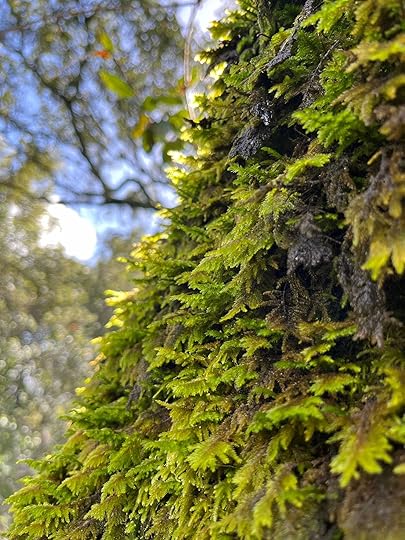 Appreciating time outside on a walk from my parents’ house in Sonoma. Facts: Measuring Regenerative Ag
Appreciating time outside on a walk from my parents’ house in Sonoma. Facts: Measuring Regenerative Ag What can farmers do to help slow climate change?
One option is to use farming practices that pull carbon from the air (where it causes warming, boo!) to soil (where it benefits ecosystems and slows climate change, yay!).
There’s lots of interest in carbon-enhancing or “regenerative” farming. (Regenerative farming is poorly defined. It most often refers to farming outcomes, like improving soil health and organic matter, but can also refer to farming practices like planting cover crops.)
So far, though, there’s very little data to quantify how much regenerative agriculture can actually achieve the outcome of increased carbon storage in soils.
In a brand-new study, Jessica Villat and I showed that seven regenerative practices can indeed help increase carbon storage in agricultural soils. The practices are:
Animal integration: Using animals on cropland, like sheep grazing in vineyards
Non-chemical pest management: Eliminating chemical inputs like herbicides & pesticides
Cover crop: Growing vegetation amidst the harvested crop, like in vineyard alleys and under the vines
Legume cover crop: Using a nitrogen-fixing cover crop instead of adding fertilizer
No-tillage: Eliminating soil plowing, or reduced and rotational tillage with shallow organic amendments
Agroforestry: Integrating trees and shrubs with the main crop
Non-chemical fertilizer: Replacing synthetic with organic fertilizers
Combining two practices (for example, cover crops + no-tillage) may further enhance carbon storage.
Overall, we found woody perennials like grapevines (blue bars below) took up more carbon than annual crops (orange bars), meaning winegrowing seems particularly favorable for regenerative ag. Here’s our data:
 Average carbon sequestration for regenerative agricultural practices on annual and woody perennial cropland. N= number of samples found in the literature for each practice and land use. Source: Villat and Nicholas, 2024, Frontiers in Sustainable Food Systems
Average carbon sequestration for regenerative agricultural practices on annual and woody perennial cropland. N= number of samples found in the literature for each practice and land use. Source: Villat and Nicholas, 2024, Frontiers in Sustainable Food SystemsIn total, we found 345 measurements in the literature of regenerative practices that met our study criteria. Of these, almost 3/4 were reported for annual croplands, and over 2/3 were for the impact of one practice, non-chemical fertilizer.
So we need more research in perennial systems like vineyards, and for the practices that only report a handful of cases. We point out that small sample sizes prevented us from demonstrating statistically significant differences between practices or land uses (except for non-chemical fertilizer). The practices with the largest sample sizes (and thus the most reliable estimates) had among the lowest estimated carbon storage rates, so it’s important to be cautious about current estimates of the quantitative potential for regenerative ag to sequester carbon.
Still, we found evidence that all seven of the regenerative farming practices we studied contribute to soil carbon storage, perhaps especially when combined. These practices also provide other benefits, and there is good reason to expand and support farming practices that are good for soil, health, and climate.
Feelings: What should we do? What can I do?I recently had the chance to visit a bunch of smart people doing cool things at MIT, like Dr. Ariel Furst, who is developing self-fertilizing seeds coated in beneficial microbes.
As you know, dear reader, I’m cautious about over-relying on tech solutions to the climate crisis. Research shows unrealistic expectations for technology to solve climate change decreased (1) climate policy support and (2) political engagement, two things we desperately need more of! Vague handwaving about possible technical breakthroughs down the road can even be used as a discourse of climate delay.
But! I loved the way the folks I met at MIT were thinking about the climate problem. They looked at a problem that needs to be solved, like producing zero-carbon energy, or sustaining productive food systems on healthy soils. They looked at their own skill set. And they found a way to apply their strengths towards solving a big, important problem.
To make this approach work, it’s key to solve the right problem. A common beef I have with tech solutions is that they often solve the wrong problem, or sometimes they’re a solution in search of a problem. (Like the current over-focus on carbon removal, without adequate emphasis on the need to eliminate carbon pollution in the first place.)
But when you see people look at root causes, and do what they can to solve a problem— it’s a beautiful thing to behold. It’s inspiring to see folks applying their creativity and energy to big important problems. It’s exciting to see real progress and imagine things getting better.
So right now I’m feeling energized by asking:
What should we do? What would a society and a world who cared about climate stability, justice, people, and nature do?
What can I do? What can I personally do to help create the conditions to move in that direction? As my friend Josh says, what can I do to show up and do my part?
What do you think? I’d love to hear your answers in the comments.
Action: 1,000 Hours Outside Source: QuoteFancy
Source: QuoteFancyFor 2024, I aim to spend 1,000 hours outside. Want to join me??
I can feel my mood is better and I have more energy when I spend regular time outdoors. Many of my favorite moments from last year happened outside: getting out on the water for a quick sail before sunset; marveling at how much the beans have grown in the garden; noticing the light through the leaves while reading in the hammock; a moonlight forest walk with friends through the first snow.
And research shows time in nature builds a sense of place, as well as a sense of agency and responsibility to protect nature.
1,000 hours feels ambitious to me, but I know I already spend more time than that on screens, which isn’t always contributing to making me feel good.
(1,000 hours/365 days = 2.7 hours/day outside. My phone tells me I average around 4 hours/day on that tiny screen alone, ack!!)
According to @1000hoursoutside, the average American kid spends about
☀️25-40 hours in unstructured play outside, and
📱 1,200 hours on screens each year.
I hope this challenge will help nudge me to choose sunshine over screens when I can. Whatever number I hit, building a habit of daily time outside (especially in Swedish winter, and when my routines are disrupted by travel) will feel like a win for me.
I want to be spending time enjoying and connecting with my environment. And this practice will keep me connected to my work to protect the places I love.
How does it work?I was aiming for 1 hour per day in January, and I made it! (42.5 hours and counting.) I’ll aim to increase my time outside with longer, sunnier days ahead. :)
Adjusting throughout the year was a tip from @1000HoursOutside on Instagram— check out how it adds up!
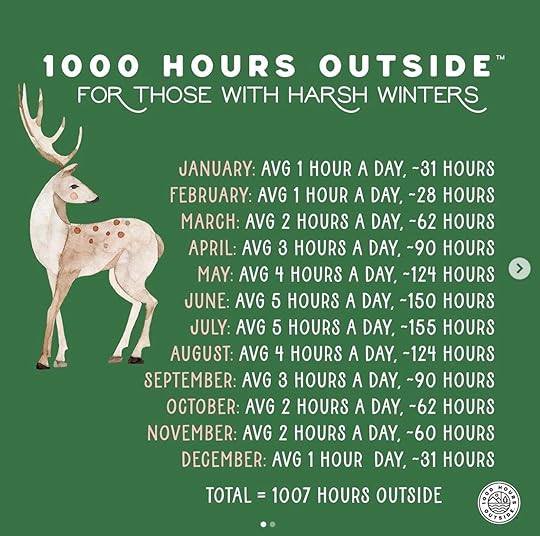
There are lots of ways to keep track of your time outside, on paper or digitally. I don’t want to feel too rigid about it, so I gave up on using timers and just make a rough time estimate in my head. (I also learned that Apple Watch estimates “Time in Daylight” under Health.)
I found it easy to use the 1000 Hours Outside app (it costs $3.99) to keep track by day. (I love the idea of their analog coloring sheet, but I’ve been moving around a lot this month and it was harder for me to keep up.)
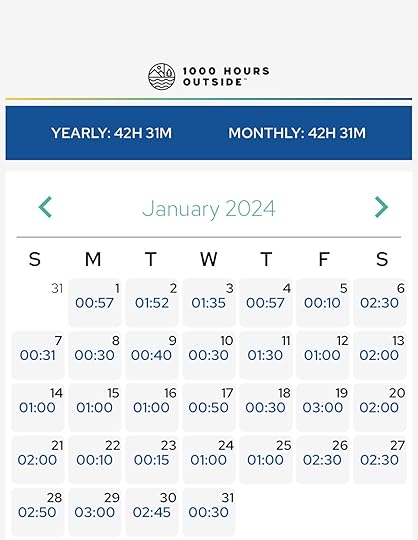 My time spent outside in January 2024. Reported using the 1000 Hours Outside app. Note, I only recommend things I independently use & love— no sponsored content.Some ways I’ve found to get outside so far:
My time spent outside in January 2024. Reported using the 1000 Hours Outside app. Note, I only recommend things I independently use & love— no sponsored content.Some ways I’ve found to get outside so far: Having morning coffee on the porch/balcony.
Bringing a meal outside.
Scheduling a phone call instead of a Zoom to have a walking meeting with headphones, and encouraging my conversation partner to join me!
Taking a friends’ dog for a walk.
If the sun is shining, trying to get out to enjoy it now, at least for 10 minutes— screen work can wait until it’s cloudy!
Telling friends I’m visiting that I want to go for a hike with them.
Taking a walk for the last 15 minutes of a conference lunch break.
Walking between meetings instead of taking a bus.
Suggesting we sit outside when meeting friends for coffee or lunch.
Picking up trash on a hike last weekend. (I’d forgotten to bring a trash bag, but a kind stranger shared one of her dog poop bags!)
Rediscovering the joy of birding, thanks to my friend Jennifer who brought binoculars on our walk.
Downloading the free Merlin Bird ID app from Cornell, which identifies birds by song. It’s incredible how many species live even in suburban backyards!
How are you planning to get outside in 2024? Do you want to join me in aiming for 1,000 hours, or whatever feels like the right goal for you? Let me know in the comments. 👇
Thanks for reading! Please share this post with a friend to spread climate action.
P.S. Thanks to Jennie @cedarhavenhomestead for posting her family’s 2nd year in a row of spending 1,000 hours outside and inspiring me!
Parting TidbitsOkay, I know We Can Fix It readers have some strong and varied views on the Swedish monarchy. Here’s my thoughts for The Guardian for their story on how elites can help shape a cultural shift:

Podcast Recommendation:
“Elites are role models and have a big influence in setting cultural norms and aspirations,” said Kimberly Nicholas, a sustainability scientist at Lund University in Sweden. “When you see our crown princess in jeans, hiking along a trail you can reach by public transport an hour from your house, it sends the signal that the high life can be low carbon.
“These images plant a seed. Maybe when people are planning their next holiday, they think of a train trip to explore a new part of the country, rather than a flight to an exotic beach.”
Quoted from Ajit Niranjan’s article in The Guardian
Electric Avenue, SOLD OUT: Rethinking Housing in America. This was a fantastic listen, about a block in East Oakland mobilizing to collectively electrify and ditch natural gas on a neighborhood scale. It’s not straightforward, but it’s inspiring to see a high-impact action like this scaling up. Have a listen, and consider starting a chat group for your own block??
xo,
Kim
This post is free to make climate action accessible to everyone. Please subscribe to receive new posts. If you find my work valuable and are financially able, I am grateful for any support you can give as a paid subscriber.



